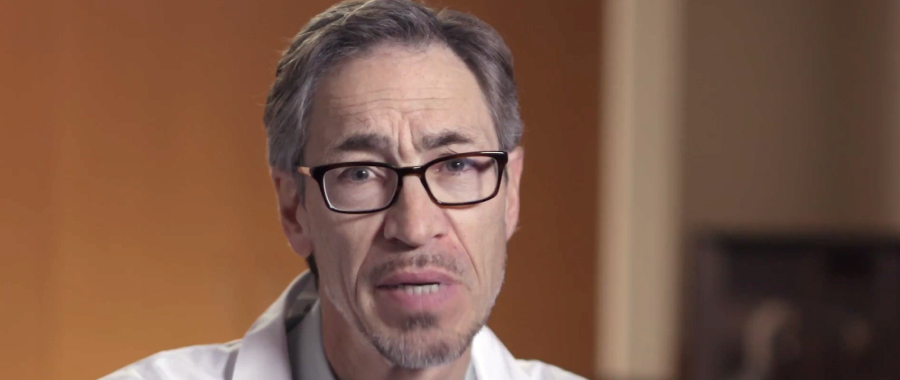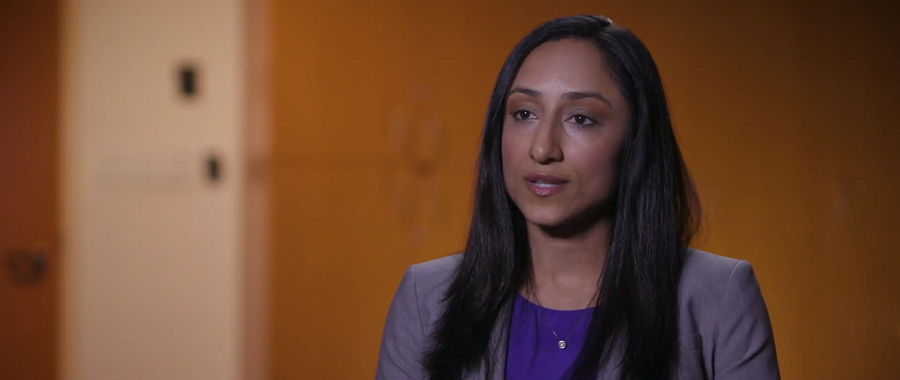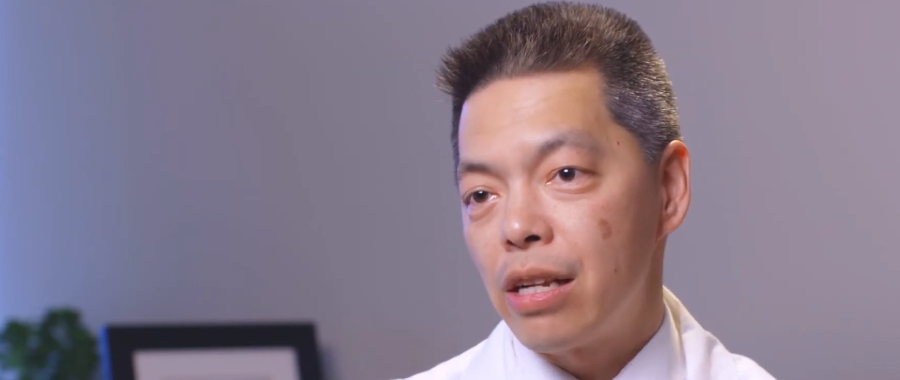The specialists at Stanford Health Care are experts in diagnosing and treating all types of lung cancer. People from around the world come to us for our multispecialty team, advanced treatment options, and compassionate care. Our lung cancer (“thoracic”) surgeons focus their practices on lung cancer – they are not unspecialized “CT surgeons” who also do cardiac surgery.
What is lung cancer?
Cancer starts when cells mutate (change abnormally) and begin growing out of control. When the abnormal cells multiply enough, they can form a tumor.
Some tumors that form in the lung are benign (noncancerous). Malignant (cancerous) lung tumors can grow into nearby tissues or spread to other parts of the body (metastasize).
What causes lung cancer?
Lung cancer often results from prolonged exposure to tobacco smoke, from either smoking or being around secondhand smoke. Exposure to substances such as radon gas or asbestos, or prior radiation treatment to the chest, can increase the risk of lung cancer. People of certain races have a greater risk of developing lung cancer, even if they never smoked. Asian women are at particularly high risk.
People who have had lung cancer before have a higher chance of developing it again. People with a close relative who has had lung cancer are at a slightly higher risk of the disease.
Connect to Care
Let us help find personalized care options for you and your family.
Lung cancer symptoms
Sometimes, people have no symptoms of lung cancer, and screening or imaging tests for other conditions detect the lung tumor. Signs and symptoms of lung cancer include:
- Coughing, including with blood
- Hoarse voice
- Shortness of breath
- Respiratory infections that won’t go away
- Sudden, unexplained weight loss
- Pain elsewhere in the body
Lung cancer risk factors
Certain factors can increase the risk of developing lung cancer. Having one or more risk factors does not mean you will develop cancer, and some people with no risk factors develop the disease.
Lung cancer risk factors include:
- Smoking tobacco
- Exposure to secondhand tobacco smoke
- Exposure to radon, a radioactive gas found in soil or rock
- Exposure to cancer-causing substances, including asbestos, arsenic, beryllium, cadmium, chromium, coal smoke, diesel fumes, nickel, silica, and soot
- Personal or family history of lung cancer
- Personal history of chronic obstructive pulmonary disease (COPD) or pulmonary fibrosis
- Prior radiation therapy for cancers of the chest, head and neck, or esophagus during childhood through early adulthood
Lung cancer prevention
The best prevention for lung cancer is to avoid exposure to tobacco smoke and certain workplace substances such as asbestos and radon gas. Regular exercise and a heathy diet rich in fresh fruits and vegetables can also support your overall health.
For those who have smoked, your risk increases with the number of cigarettes you smoke daily and the number of years you have smoked. Quitting at any age lowers your risk of developing lung cancer.
Lung cancer screening
If you currently smoke, used to smoke, or have other lung cancer risk factors as outlined above, your doctor may recommend lung cancer screening. We offer comprehensive, in-depth assessments at our Lung Cancer Screening Program.
Additionally, our Lung Nodule Surveillance and Cancer Detection Program offers testing and monitoring of lung nodules (small masses of tissue in the lung that may or may not be cancerous).
Types of lung cancer
Doctors categorize types of lung cancer by the way the cells look under a microscope. The two main types of lung cancer are non-small cell lung cancer and small cell lung cancer.
Non-small cell lung cancer (NSCLC) is more common and grows more slowly than small cell lung cancer. The types of non-small cell lung cancer are:
- Adenocarcinoma usually begins in the outside areas of the lung and under the lining of the bronchi (air passages in the lungs). It is the most common type of lung cancer in people who have never smoked.
- Squamous cell carcinoma, also called epidermoid carcinoma, often begins in the bronchi near the middle of the lungs.
- Large cell carcinomas are a group of cancers with large, abnormal-looking cells. These tumors may begin anywhere in the lungs.
Small cell lung cancer (SCLC) is a form of neuroendocrine cancer, which happens when neuroendocrine tumors form in the lungs. SCLC grows and spreads faster than NSCLC and has two stages:
- Limited-stage small cell lung cancer is usually in one lung. Nearby lymph nodes on the same side of the chest may also have cancer.
- Extensive-stage small cell lung cancer has spread beyond the primary tumor in the chest to other parts of the body.
Neuroendocrine lung cancer, also called carcinoid cancer, is rare and tends to grow more slowly than other lung cancer types. In addition to SCLC, other neuroendocrine lung cancer types include:
- Large cell neuroendocrine carcinoma is similar to SCLC but has larger cancerous cells.
- Atypical carcinoid tumors are less common and faster growing than typical carcinoid tumors.
- Typical carcinoid tumors are more common and slower growing than atypical tumors.
Lung cancer stages
When your care team determines your lung cancer diagnosis, they also assess what stage of cancer you have. Staging describes:
- Size of the tumor
- Location of the cancer
- Whether the cancer has spread and, if so, where
A cancer diagnosis and its staging help you and your doctor make decisions about your treatment plan. This information is also helpful in determining your prognosis (probable outcome based on the experience of others).
The stages of lung cancer are:
- Stage 1 lung cancer is in the lung but has not progressed to the lymph nodes or distant organs.
- Stage 2 lung cancer has spread from the lungs to nearby lymph nodes.
- Stage 3 lung cancer has spread to slightly more distant lymph nodes within the chest.
- Stage 4 lung cancer, also called metastatic lung cancer, has progressed beyond the lung to distant lymph nodes and other organs.
- Recurrent lung cancer has come back after prior lung cancer treatment.
Medical and family history
Your doctor wants to learn about your medical history, lifestyle, and substances you have been exposed to. Your family’s medical history can also provide insights about possible inherited genetic conditions.
Diagnostic tests
Based on your symptoms and screening test results, you and your doctor discuss the tests you need. We use several diagnostic methods, including:
- Bronchoscopy with ultrasound
- Blood tests
- Lung function tests
Imaging tests
Imaging tests take pictures of the inside of your chest to provide more information about your condition. Tests can include:
- Computed tomography (CT) scan
- Magnetic resonance imaging (MRI), usually of the brain or other areas which can harbor metastatic cancer
- Positron emission tomography (PET) scan
- X-ray
Genetic testing
Genetic testing identifies changes in genes, chromosomes, or proteins. For lung cancer, genetic testing can show whether you have inherited mutations in genes related to the disease.
Biopsy
To confirm a diagnosis, our doctors perform a biopsy to take a small sample of cells from abnormal lung tissue. Types of lung biopsy include:
- Needle biopsy: An interventional radiologist inserts a thin needle (fine needle aspiration) or a wider needle (core biopsy) between the ribs and into the lung to remove cells.
- Bronchoscopic biopsy: An interventional pulmonologist or thoracic surgeon uses an imaging technique such as ultrasound or CT during a bronchoscopy procedure to guide the needle to the tumor for the biopsy.
- Surgical (or excisional) biopsy: In some cases, your surgeon may remove all or part of a tumor without the need for preliminary needle or bronchoscopic biopsy.
Next steps
If your care team finds evidence of lung cancer, you and your doctor will discuss the right treatment plan for you. We offer a variety of treatments that are personalized to your specific diagnosis and needs.
We’re here to help you and your family each step of the way. You can find support through our Cancer Care Services for every aspect of your care—physical, emotional, spiritual, and social.
Lung Cancer
Learn about our innovations in lung cancer diagnosis and treatment. We offer advanced, compassionate care for non-small cell and small cell lung cancer.
non-small cell lung cancer
small cell lung cancer
stage 4 lung cancer
adenocarcinoma lung
lung cancer treatment
lung cancer screening
metastatic lung cancer



